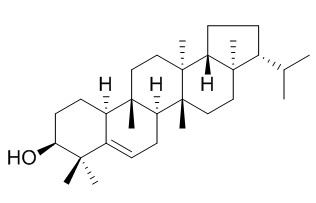Simiarenol
Simiarenol may have in vitro leishmanicidal activity against Leishmania donovani promastigotes.
Inquire / Order:
manager@chemfaces.com
Technical Inquiries:
service@chemfaces.com
Tel:
+86-27-84237783
Fax:
+86-27-84254680
Address:
1 Building, No. 83, CheCheng Rd., Wuhan Economic and Technological Development Zone, Wuhan, Hubei 430056, PRC
Providing storage is as stated on the product vial and the vial is kept tightly sealed, the product can be stored for up to
24 months(2-8C).
Wherever possible, you should prepare and use solutions on the same day. However, if you need to make up stock solutions in advance, we recommend that you store the solution as aliquots in tightly sealed vials at -20C. Generally, these will be useable for up to two weeks. Before use, and prior to opening the vial we recommend that you allow your product to equilibrate to room temperature for at least 1 hour.
Need more advice on solubility, usage and handling? Please email to: service@chemfaces.com
The packaging of the product may have turned upside down during transportation, resulting in the natural compounds adhering to the neck or cap of the vial. take the vial out of its packaging and gently shake to let the compounds fall to the bottom of the vial. for liquid products, centrifuge at 200-500 RPM to gather the liquid at the bottom of the vial. try to avoid loss or contamination during handling.
Phytomedicine.2021, 83:153483.
Cancers (Basel).2021, 13(6):1432.
J Agric Food Chem.2024, 72(42):23183-23195
University of Stuttgart2021, 11682.
Molecules.2019, 24(16):E2985
Pak J Pharm Sci.2019, 32(6)
Phytomedicine.2015, 22(4):498-503
Pharmacognosy Journal.2020, 12(2), p232-235.
J Agric Food Chem.2018, 66(1):351-358
Anal Bioanal Chem. 2016, 408(15)
Related and Featured Products
Planta Med. 2011 Jul;77(11):1183-8.
Antiproliferative constituents of the roots of Conyza canadensis.[Pubmed:
21294076]
METHODS AND RESULTS:
Bioassay-guided fractionation of the N-hexane and CHCl₃ phases of the methanol extract of the roots of Conyza canadensis (L.) Cronquist led to the isolation of two new dihydropyranones named conyzapyranone A (1) and B (2), and the known 4 Z,8 Z-matricaria- γ-lactone (3), 4 E,8 Z-matricaria- γ-lactone (4), 9,12,13-trihydroxy-10(E)-octadecenoic acid (5), epifriedelanol (6), friedeline (7), taraxerol (8), Simiarenol (9), spinasterol (10), stigmasterol, β-sitosterol, and apigenin. The structures were determined by means of ESIMS and 1D and 2D NMR spectroscopy, including ¹H-¹H COSY, NOESY, HSQC, and HMBC experiments. The isolated compounds were evaluated for their antiproliferative activities and were demonstrated to exert considerable cell growth-inhibitory activity against human cervix adenocarcinoma (HeLa), skin carcinoma (A431), and breast adenocarcinoma (MCF-7) cells.
CONCLUSIONS:
Some of the active components, including 2, 4, and 10, proved to be substantially more potent against these cell lines than against noncancerous human foetal fibroblasts (MRC-5) and can therefore be considered selective antiproliferative natural products.
Saudi Pharm J. 2017 Feb;25(2):236-40.
Biologically-guided isolation of leishmanicidal secondary metabolites from Euphorbia peplus L.[Pubmed:
28344474 ]
Leishmaniasis is a worldwide health problem, highly endemic in developing countries. Moreover, the severe side effects and the reported drug resistance make it an urgent need to search for effective drugs that can replace or supplement those currently used.
METHODS AND RESULTS:
In a research program designed to investigate the antileishmanial activity of plants collected from the Egyptian flora, twenty extracts from fifteen plants growing in Egypt have been investigated for in vitro leishmanicidal activity against Leishmania donovani promastigotes. Among the tested extracts, the methanol extract of Euphorbia peplus aerial parts exhibited a significant antileishmanial activity as it produced 100% inhibition of growth with activity similar to amphotericin B. The total extract was subjected to liquid-liquid fractionation using solvents of different polarities, followed by testing the antileishmanial activity of the successive fractions. Phytochemical exploration of the active n-hexane fraction (which produced 75% inhibition of growth) led to isolation of four compounds: Simiarenol (1), 1-hexacosanol (2), β-sitosterol (3), and β-sitosterol-3-O-glucoside (4) from the biologically active sub-fractions. Structure elucidation was aided by 1D and 2D NMR techniques.
CONCLUSIONS:
In conclusion, E. peplus plant has many non-polar secondary metabolites that can be used as drug leads for treatment of leishmaniasis.
Arch Pharm Res. 2001 Aug;24(4):312-5.
Phytochemical constituents of Artemisia stolonifera.[Pubmed:
11534763]
METHODS AND RESULTS:
Repeated column chromatographic separation of the CH2Cl2 extract of Artemisia stolonifera (Asteraceae) led to the isolation of a triterpene (I), a sesquiterpene (II), two aromatic compounds (III and IV) and a benzoquinone (V). Their structures were determined by spectroscopic means to be Simiarenol (I), (1S,7S)-1beta-hydroxygermacra-4(15),5,10(14)-triene (II), 3'-methoxy-4'-hydroxy-trans-cinnamaldehyde (III), vanillin (IV) and 2,6-dimethoxy-1,4-benzoquinone (V), respectively.
CONCLUSIONS:
Among these products, compound V showed significant cytotoxicity against five human tumor cell lines in vitro, A549 (non small cell lung adenocarcinoma), SK-OV-3 (ovarian), SK-MEL-2 (skin melanoma), XF498 (CNS) and HCT15 (colon) with ED50 values ranging from 1.33-4.22 microg/ml.
Zhongguo Zhong Yao Za Zhi. 2012 Aug;37(15):2296-300.
[Chemical constituents from Imperata cylindrica].[Pubmed:
23189737]
METHODS AND RESULTS:
Chemical investigation of Imperata cylindrica led to the isolation of thirteen compounds using various chromatographic techniques. The structure of these compounds were identified as: three phenylpropanoids, 1-(3,4,5-trimethoxyphenyl)-1,2,3-propanetriol ( 1 ), 1-O-p-coumaroylglycerol (2), 4-methoxy-5-methyl coumarin-7-O-beta-D-glucopyranoside (3); four organic acids, 4-hydroxybenzene carboxylic acid(4), 3,4-dihydroxybenzoic acid (5), vanillic acid (6), 3, 4-dihydroxybutyric acid (7); one phenolic compound, salicin (8); and five triterpenes, namely, arundoin (9), cylindrin (10), fernenol (11), Simiarenol (12), glutinone (13) by their physicochemical properties and spectral data analysis.
CONCLUSIONS:
Among them, compounds 1-8 were isolated from the genus Imperata for the first time.



